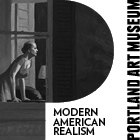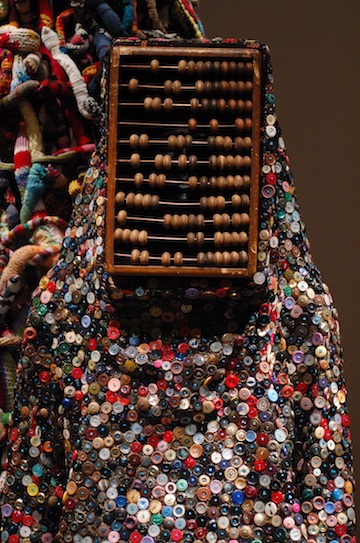
"Meet Me at the Center of the Earth", Seattle Art Museum 2011
What does the sound of protest look like? What is the shape and color of its voice?
For the artist Nick Cave, protest is an aggressive celebration, a measure of life itself, a reified form of soul. Existence is an event to be heard, and its sound moves in color. "Meet Me At The Center of the Earth", Cave's current exhibition at the Seattle Art Museum, is a parade of symbolic freedoms granted by the imagination and made real by human hands.
Upon entering the exhibition, a bear made of sweaters greets you stoically. As tall as an actual grizzly bear, this is the only recognizable animal form in the show, and the only suit who has a face. The bear's face renders it complex, identity burdened, and vulnerable. This is the only suit to make eye contact, and the naked nature of this look is disarming. The bear introduces the viewer to Cave's world, and beyond him begins Cave's raucous confrontation to costume and chromophobia.
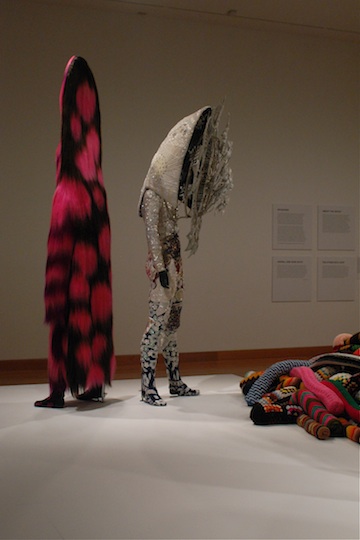
"Meet Me At the Center of the Earth", Seattle Art Museum, 2011
This animal sets the tone for the exhibition; its fierce solemnity hums beneath all of the work's seemingly boundless visual freedom and Cave's apparent childlike abandon in his use of color and material. There is a sobriety of gravity and consequence and purpose. It is the sobriety of danger and falling. The somber notions understood in these playful forms is unexpected and counterintuitive, and thus (perhaps) more fierce. To be in the presence of these suits inspires the sensation of religion, and the suits feel like deities as they roam the museum, pondering the next directions of the earth's inhabitants. In the sobering moments of being confronted by God or death, the revelation of the latent power of events occurring to alter an era is palpable. In these moments, the ferocity of the instant is concrete and sharp, and the gravity of the outcome weighs heavy against the blade of such ferocity. As the creation of Cave's first soundsuit was brought about by a reaction to the Rodney King beatings, rivers of violence, outrage, freedom, fantasy, possibility and the desire to be seen and heard are themes that run through this work. It is not so much individuality as spirit that Cave seems to want to convey, and each suit seems to embody a character that cannot be stereotyped, ironically achieving the desire of every individual. "Meet Me At the Center of the Earth" hearkens to the spirit of Jim Henson, whose work employed fantasy to discuss societal conundrums and injustices. Fraggle Rock was one such project that entailed a cast of characters that lived and worked underground. While color and freedom and fun were the conduits of creation for Henson's projects, issues of race, neuroses, and human relationships were at the center of his stories; the characters embodied daily life while maintaining an ultimate freedom of color and shape.
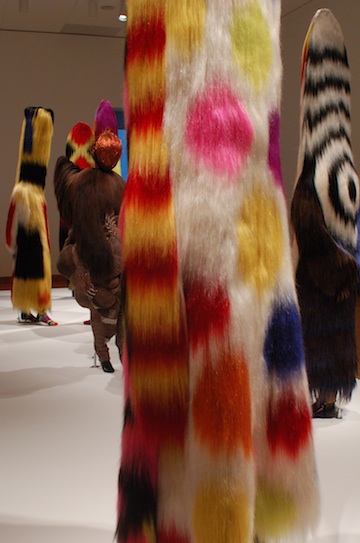
"Meet Me At the Center of the Earth", Seattle Art Museum, 2011
The audience and platform of viewing for these two creators could not be more different, yet their congruity lies in the unexpected poignancy of legible symbol in such fantastical realized form. Cave creates characters who appear regal, monkish, meek, threatening, and confrontational. In addition to Jim Henson, Cave's work also engenders conversations with the obsession of Simon Rodia's Watts Towers, the symbolic apparel of high fashion's Hussein Chalayan, and acts as the consumerist antithesis and co-commentator of Andy Warhol's ideology. Cave appropriates a myriad of common objects and abject americana (not iconic but commonplace and recognizable), and capitalist consumerism is tangentially referenced, yet Cave's appropriation is more about recreation and recontextualizing than consumerism itself.
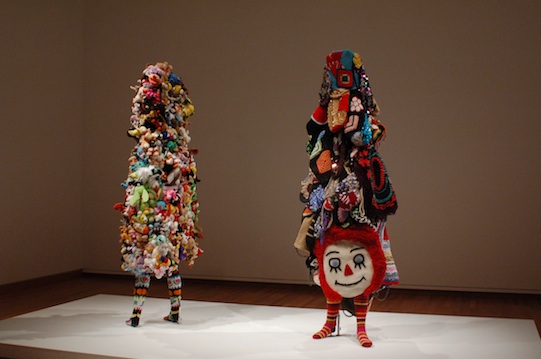
"Meet Me At the Center of the Earth", Seattle Art Museum, 2011
The soundsuits have an unmistakable reference to characters created within the magical realism of folklore and the raw expressions of tribal ritual. The soundsuit, according to Cave, is a reaction to the conventional white collar business suit, and in essence, to the common acceptance of the definition of visual sophistication which are often too limiting. There is magic and surprising tradition present in Cave's creations, as he infuses the sacred into inane objects and makes reference to peoples silenced and spirits denigrated. These soundsuits perhaps will one day be in the Smithsonian as opposed to the art museum, reconsidered as sacred artifacts of this time.
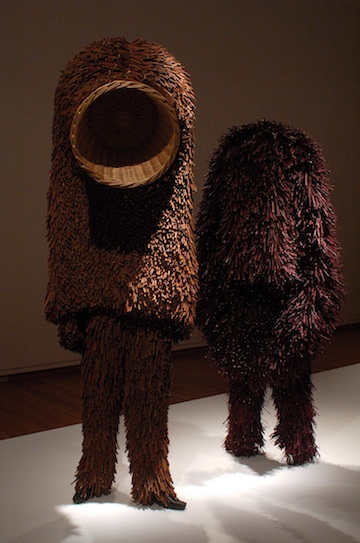
"Meet Me At the Center of the Earth", Seattle Art Museum, 2011
Cave sews these suits with the free form of an abstract painter. His motivations initially answered a provocation of horror, and his response was and is one of such grace and otherworldly beauty that one cannot help but wonder of the possible allegory in it: violence subverted by sequins. For this artist, protest is celebratory and magical. He turns the seeking inward outward, in an armature of birds and spinning tops, flowing furs, buttons, and twigs: a sensitive child's armor with the darkness of adulthood. Cave's soundsuits push a visual invention that adheres to no heirarchy. They revel in spirit and the idea that to exist comes with the permission to take up space and make noise, and that this is necessary in order to represent the infinite complexity of the human experience. The suits are confrontational while contemplative, outraged while inquisitive, declarative, imperative, and hungry. . .In a mask and without a face, we are actually free, identityless and all spirit, the truest individual, equal parts virtue, equal parts evil, every part present. Their voice noise is percussive, minimal, rhythmic and eloquently saddled with stark solemnity.
Sometimes protest arms itself with joy.
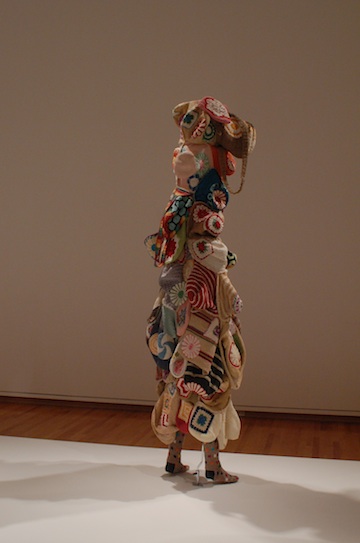
"Meet Me At the Center of the Earth", Seattle Art Museum, 2011
"Meet Me at the Center of the Earth" will be on view at the Seattle Art Museum until June 15.



